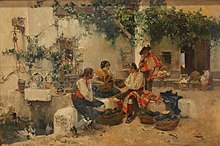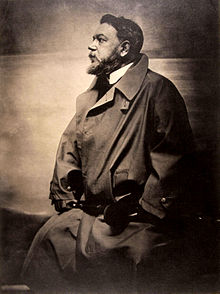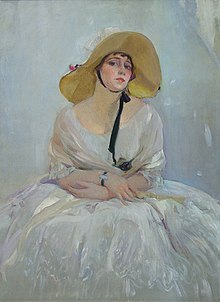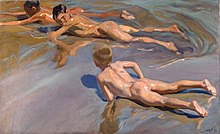Joaquin Sorolla
Joaquín Sorolla Bastida (Valencia, February 27, 1863-Cercedilla, August 10, 1923) was a Spanish painter. A prolific artist, he left behind more than 2,200 cataloged works. His mature work has been labeled Impressionist, Post-Impressionist, and Luminist.
Biography
When he was barely two years old, his parents Joaquín Sorolla Gascón and María Concepción Bastida Prat died, killed by a cholera epidemic. When they became orphans, he and his sister Concha were welcomed by their aunt Isabel, his mother's sister, and her husband, a locksmith by profession. As the years passed, his uncle tried in vain to teach him the trade of locksmithing, soon realizing that his true vocation was painting.
He studied drawing at the "Escuela de Artesanos de Valencia". He shared a studio on the ground floor of calle Las Avellanas n.º 12 in Valencia with José Vilar y Torres, the Benlliure brothers —Blas, José and Juan Antonio— and Ignacio Pinazo Camarlench. Upon finishing his training, he began to send his works to provincial competitions and national exhibitions of fine arts, such as the one in Madrid in May 1881, where he presented three Valencian seascapes that went unnoticed, since they were not they fit in with the official painting, with a historical and dramatic theme.
The following year he studied the work of Velázquez and other authors at the Prado Museum. After visiting the Prado Museum, in 1883 Sorolla painted the unpublished canvas Study of Christ, discovered in 2012, where the influence of Velázquez's Crucified Christ is observed. Thus began his "realist stage", being his teacher Gonzalo Salvá. Finally, in 1883, he won a medal at the Valencia Regional Exhibition, and in 1884 he achieved glory by obtaining the second class Medal at the National Exhibition thanks to his work Defense of the Monteleón artillery park, melodramatic and dark work, made expressly for the exhibition; as he told a colleague of his: "Here, to make yourself known and win medals, you have to kill people."
He achieved another great success in Valencia with his work El crit del palleter about the War of Independence. In this way, he was pensioned by the Provincial Council of Valencia to travel to Rome, where, while he was working, he got to know classical and Renaissance art, as well as the great museums, also contacting other artists.
With his friend, Pedro Gil, also a painter, he traveled to Paris during the first semester of 1885, and got up close to impressionist painting, which produced in him, once back in Rome, variations in its theme and style, He came to paint the religious painting The Burial of Christ, with which he did not have the expected success. Thus, he came into contact with the European avant-garde, highlighting the impact produced on him by the works of painters John Singer Sargent, Giovanni Boldini and Anders Zorn.
In 1888, he married Clotilde García del Castillo in Valencia, although they would live another year in Italy, this time in the town of Assisi. Some of his works are related to that period, including Selling melons (Museo Carmen Thyssen Málaga), a period in which he painted traditional and anecdotal themes, due to their easy sale. In general, they were small watercolors that his dealer, Francisco Jover, sold.
Madrid
In 1889, the painter and his family settled in Madrid and, in just five years, Sorolla would achieve great renown as a painter. In 1894, he traveled again to Paris, where he developed a pictorial style called "luminism", which would be characteristic of his work from then on. He began to paint outdoors, masterfully mastering light and combining it with everyday scenes and landscapes of Mediterranean life. In works such as La vuelta de la pesca, Valencia beach or Sad inheritance, he described the feeling produced by the vision of the Mediterranean Sea, communicating the beach-morning splendor with vibrant colors and a loose, energetic style. With Sad inheritance he received, in 1900, the Grand Prix at the international competition in Paris. In addition, he continued with his painting of social denunciation that had brought him so much success in recent years with works such as And they still say that fish is expensive (1894).
In August 1900, while in Valencia, his friend the sculptor Ricardo Causarás Casaña went to visit Sorolla to ask him to pose as a live model to sculpt a terracotta and plaster statue, somewhat larger than life, that Causarás planned to exhibit in the General Exhibition of Fine Arts in Madrid in 1901. In January 1901, Sorolla was in the sculpture studio, posing as a model for twenty days for his friend Causarás, who, in addition to sculpting his statue, also sculpted separately a bust-portrait of his head, only in terracotta, and a plaster cast of Sorolla's right hand in a painting position. In the month of May 1901, the Sorolla statue was exhibited at the General Exhibition of Fine Arts in Madrid, being awarded by the jury with «Third Class Medal Consideration in Sculpture». Subsequently, it remained on display in Valencia from 1901 to 1925, in the main room of the Círculo de Bellas Artes, finally being given to the Valencia City Council, which deposited it until mid-August 1930 in the Reales Jardines de los Viveros de Valencia.
At that time, Valencia named him a favorite and meritorious son, and a street was named after him. After many trips through Europe, mainly England and France, he held an exhibition in Paris with more than half a thousand works, which gave him unusual international recognition, his pictorial work being known throughout Europe and America.
Towards the summer of 1905 he was in Jávea and made a series of paintings of naked children, one of his most famous series and which earned him a subsequent commission from the Hispanic Society of America. One of the most outstanding paintings in the series is The Bath, from 1905 and which belongs to the collection of the Metropolitan Museum of New York.
A new project: the Sorolla house
In 1905, the painter acquired a plot of land on Paseo del Obelisco in Madrid (later Calle del General Martínez Campos), next to the residence of actress María Guerrero. In 1909, he commissioned the project to the architect Enrique María de Repullés y Vargas. Shortly after, he bought a second adjoining plot that would allow him to expand the built area and incorporate three gardens into the house. Sorolla inaugurated his new home in Madrid in 1911, after going through various studios and homes in the city —Plaza el Progreso, Pasaje de la Alhambra, Calle de Miguel Ángel—.
His financial success has been evident since 1905. In part, it also stemmed from his exhibition in New York in 1909, which achieved unprecedented success, with works such as Afternoon Sun or Swimmers , among many others. He, too, triumphed in 1911, at the St. Louis Museum of Art and at the Art Institute of Chicago.
The commission of the Hispanic Society
In November of that same year, he signed a commission for the Hispanic Society of America, for which he would create fourteen murals that would decorate the halls of the institution, and dedicated to the Regions of Spain. With this work carried out between 1913 and 1919, three and a half meters high by seventy meters long, he raised an indelible monument to Spain, since it depicted scenes characteristic of various Spanish and Portuguese provinces. It took him most of the year of 1912 to travel all over the country, making sketches and works of customs and landscapes. Of this task, the oil paintings painted in 1916 dedicated to children and women on the beaches of Valencia stand out, where the freedom of brushstrokes and the light of their land predominate. Some examples are Mother and daughter or Valencian fisherwoman.
Portrait painter and academic
Another important facet that he developed in those years was that of a portrait painter. Characters such as Cajal, Galdós, Machado, his countryman Vicente Blasco Ibáñez, or politicians such as Emilio Castelar, King Alfonso XIII, President William Howard Taft, the tiple Isabel Brú, as well as a good collection of portraits of his family and some self-portraits.
In 1914 he had been appointed an academic and, when he finished his work for the Hispanic Society, he worked as a professor of composition and color at the School of Fine Arts in Madrid. In 1920, while he was painting the portrait of Ramón Pérez de Ayala's wife in the garden of his house, he suffered a hemiplegia that impaired his physical faculties, preventing him from continuing to paint. He died three years later at his summer residence in Cercedilla on August 10, 1923.
Legacy and followers
In 1932, his house in Madrid was reopened as the Sorolla Museum. His main disciple was Teodoro Andreu.
Work
Formation period (1863-1888)
- Feet study (1876-79)
- Exotic (1876-79)
- Conception of the Venerable (1876-79)
- Sleeping child (1876-79)
- Portrait of old (ca.1880)
- Marina (1881)
- Saint Louis, King of France (1882)
- Study of Christ (1883)
- Copier of Velázquez Horse Head (1883)
- Father Jofré defending a madman (1887)
Consolidation period (1889-1899)
- The guitarists, Valencian customs (1889)
- The fountain, Buñol (1890-1895)
- The beach pill (1891)
- The kiss of the relic (1893)
- Traffic in white (1894)
- They still say fish is expensive. (1894)
- Portrait of Benito Pérez Galdós (1894)
- Mother (1895)
- Cooking the candle (1896)
- Joaquín Sorolla García dressed in white (1896)
- An investigation (1897)
- Food in the boat (1898)
- Cordeleros de Jávea (1898)
- Sad heritage (1899)
Culmination stage (1900-1910)
- Noria, Javea (1900)
- The girl Maria Figueroa dressed as a woman (1901)
- Portrait of Beruete (1902)
- Sea and rocks of San Esteban, Asturias (1903)
- The three candles (1903)
- Oxen at sea. Estudio para “Sol de la tarde” (1903)
- In the shadow of the boat, Valencia (1903-1904)
- Authorport (1904)
- My children (1904)
- The boy from the barquita (1904)
- The fisherman (1904)
- Ramillete de mandarins (1904).
- Portrait of the Isabel Brú (1904)
- swimmers, Javea (1905)
- Rocks of Javea and the White Boat (1901)
- Portrait of Santiago Ramón y Cajal (1906)
- Instant, Biarritz (1906)
- María Guerrero (1906)
- Storm on Peñalara, Segovia (1906)
- Convalescent Mary (1907)
- Jumping to the comba, La Granja'' (1907)
- Fuente del Alcázar de Sevilla (1908)
- Running down the beach. Valencia(1908)
- Fisherman with your son, Valencia (1908)
- Reflexes from a source (1908)
- Walk on the shores of the sea (1909)
- The horse bath (1909)
- Guys on the beach (1910)
- My wife and daughters in the garden (1910)
- Clotilde sitting on a sofa (1910)
- Clotilde with evening suit (1910)
- Under the awning, Zarauz Square (1910)
- Jardines de Carlos V, Alcázar de Sevilla (1910)
- Garden of the Adarves, Alhambra of Granada (1910)
Final stage (1911-1920)
- Vision of Spain (sketches, notes and tables for the Hispanic Society)
- Castile: The Feast of the Bread (1913)
- Seville: Los Nazarenos (1914)
- Aragon: La jota (1914)
- Navarre: The council of Roncal (1914)
- Guipúzcoa: The Bolos (1914)
- Andalusia: El encierro (1914)
- Seville: the dance (1915)
- Seville: The Bullfighters (1915)
- Galicia: La romería (1915)
- Catalonia: The fish (1915)
- Valencia: Las grupas (1916)
- Extremadura: The market (1917)
- Elche: The palm tree (1918-1919)
- Ayamonte: Tuna Fishing (1919)
- Aldeanos leoneses (1907)
- Types of the Roncal (1912)
- Valencian fishermen (1915)
- Laundries of Galicia (1915)
- After the bath (1911)
- Fifth Avenue, New York (1911)
- The nap (1912)
- Types of La Mancha (1912)
- Girl entering the bathroom (1915)
- Sorolla House Garden (c. 1916)
- The pink robe (1916)
- The courtyard of Comares, the Alhambra of Granada (1917)
- Chapel of the farm of Lachar (1917)
- Rompeolas, San Sebastian (1917-1918)
- Joaquín Sorolla and García seated (1917)
- Patio de la casa Sorolla (1917)
- Alberca del Alcázar de Sevilla (1918)
- Sorolla House Garden (1918-1919)
- Helena in the cove of Saint Vincent, Majorca (1919)
- Sorolla House Garden (1920)
Honors
Orders
- Knight Grand Cross of the Spanish and American Order of Isabel the Catholic
- Knight of the Legion of Honor
- Knight Great Cross of the Civil Order of Alfonso XII
- Commander of the Order of Saint Olaf
- Official of the Legion of Honour
- Grand Officer of the Order of the Crown of Italy
Charges
- Académico correspondiente de la Real Academia de Bellas Artes de San Carlos de Valencia.
Medals
- Second Class Gold Medal at the Munich International Exhibition for its work Rogativa in Burgos - (1892)
- First Class Medal at the National Exhibition for its work Another Margarita! - (1892)
- Gold Medal of Third Class in the Paris Society of French Artists Hall for his work The kiss of the relic - (1893)
- Second Class Medal at the IV Vienna International Exhibition for its work The kiss of the relic - (1894)
- Second Class Gold Medal at the Munich International Exhibition for its work Cooking the candle - (1896)
- Grand Medal of the Austrian State at the Vienna International Exhibition - (1897)
Contenido relacionado
Coat of arms of the netherlands
The Yardbirds
Graphic humour
















